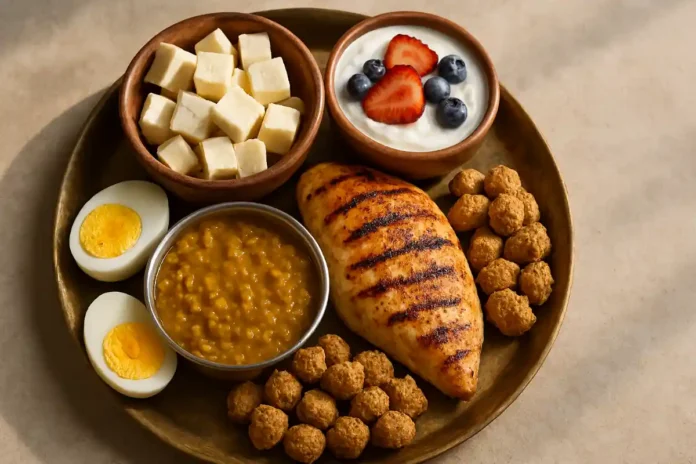7 Easy Foods For Your Daily Diet – Struggling to meet your protein needs? You’re not alone. Protein is the building block of muscles, tissues, hormones, and immunity—yet most Indians consume less than the recommended daily intake. Adults typically need around 0.8–1.2 grams of protein per kg of body weight, but the average Indian diet falls short.
The good news? You don’t need exotic supplements to fix this. Many everyday Indian foods can give you 20 grams of protein in a single serving—enough to power your workouts, keep you full, and boost energy levels.
Here’s your easy guide to 7 high-protein foods you can add to your daily meals.
🥗 7 Foods That Give You 20g of Protein For Your Daily Diet
1. Paneer (Cottage Cheese)
- Serving: 100 g
- Protein: ~20 g
- Why it’s good: Packed with slow-digesting casein protein, keeps you full for hours.
- How to eat: Raw cubes, grilled tikkas, in curries, parathas, or salads.
2. Boiled Eggs
- Serving: 3 large eggs
- Protein: ~20 g
- Why it’s good: Rich in essential amino acids + healthy fats.
- How to eat: Boiled, scrambled, omelet, or egg bhurji.
3. Chicken Breast (Grilled or Boiled)
- Serving: 100 g cooked
- Protein: 20–22 g
- Why it’s good: Lean, low-fat protein—great for muscle gain or fat loss.
- How to eat: Grilled, in curries, soups, or salads.
4. Cooked Dal (Lentils)
- Serving: 1.5 cups cooked dal (moong, masoor, or toor)
- Protein: 18–20 g
- Why it’s good: Plant-based protein + fiber = keeps digestion smooth.
- How to eat: With rice, quinoa, or rotis for a complete protein meal.
5. Greek Yogurt (Unsweetened)
- Serving: 200 g
- Protein: ~20 g
- Why it’s good: Probiotic-rich, helps gut health + muscle repair.
- How to eat: With fruits, oats, smoothies, or just plain.
6. Soya Chunks (Nutri Nuggets)
- Serving: 50 g dry (cooked later)
- Protein: ~20 g
- Why it’s good: High-protein, budget-friendly, vegan.
- How to eat: In pulao, curries, or as a dry snack.
7. Protein Shake (Whey or Plant-Based)
- Serving: 1 scoop (with water or milk)
- Protein: 20–25 g
- Why it’s good: Quick, convenient option for busy people.
- How to eat: Blend with fruits, oats, or nut butter for extra nutrition.
🥦 Vegetarian vs Non-Vegetarian Protein Sources
- Vegetarians → Paneer, soya, lentils, milk, nuts, seeds.
- Non-Vegetarians → Eggs, chicken, fish, dairy.
👉 Both can meet daily protein goals by mixing different sources.
⚡ Easy Tips to Add More Protein to Your Daily Diet
✔ Add paneer or eggs to breakfast.
✔ Snack on roasted chana, Greek yogurt, or sprouts.
✔ Pair dals with quinoa or millets instead of just rice.
✔ Sprinkle chia or flaxseeds into salads or curd.
✔ Keep a quick protein shake ready for busy days.
FAQs
How much protein do I really need daily?
Most adults need 50–70 g of protein, depending on weight, age, and activity level.
Is too much protein harmful?
Excess protein is usually safe for healthy people but may stress the kidneys in those with existing kidney issues.
Can I get enough protein on a vegetarian diet?
Yes! By combining dals, paneer, soya, nuts, and dairy, vegetarians can easily meet protein needs.
What’s the best time to eat protein for maximum benefits?
Protein timing can make a big difference depending on your goals. For muscle growth and recovery, consuming protein within 30–60 minutes after a workout helps repair muscles faster. If you want to control hunger and improve energy, include protein at breakfast—studies show that a protein-rich morning meal keeps you full longer and reduces cravings. For general health, spreading protein evenly across all meals (about 20–25 g each) is more effective than eating all your protein at once. This ensures steady energy, better digestion, and improved muscle maintenance, especially as you age.
🔑 Key Takeaway
Protein isn’t just for gym-goers—it’s for everyone. By including at least one high-protein food in every meal, you’ll stay energetic, strong, and healthy without overspending or overcomplicating your diet.
